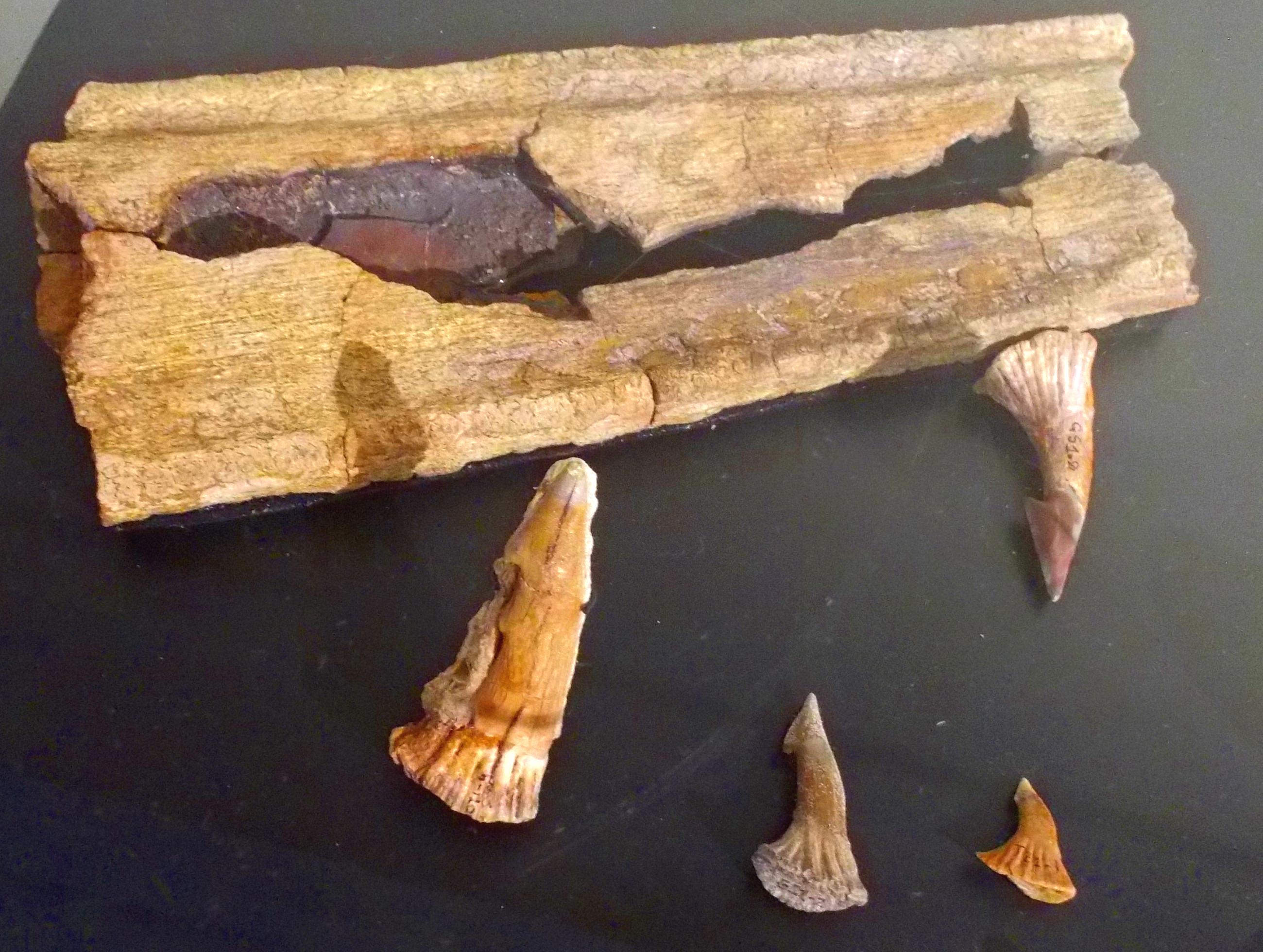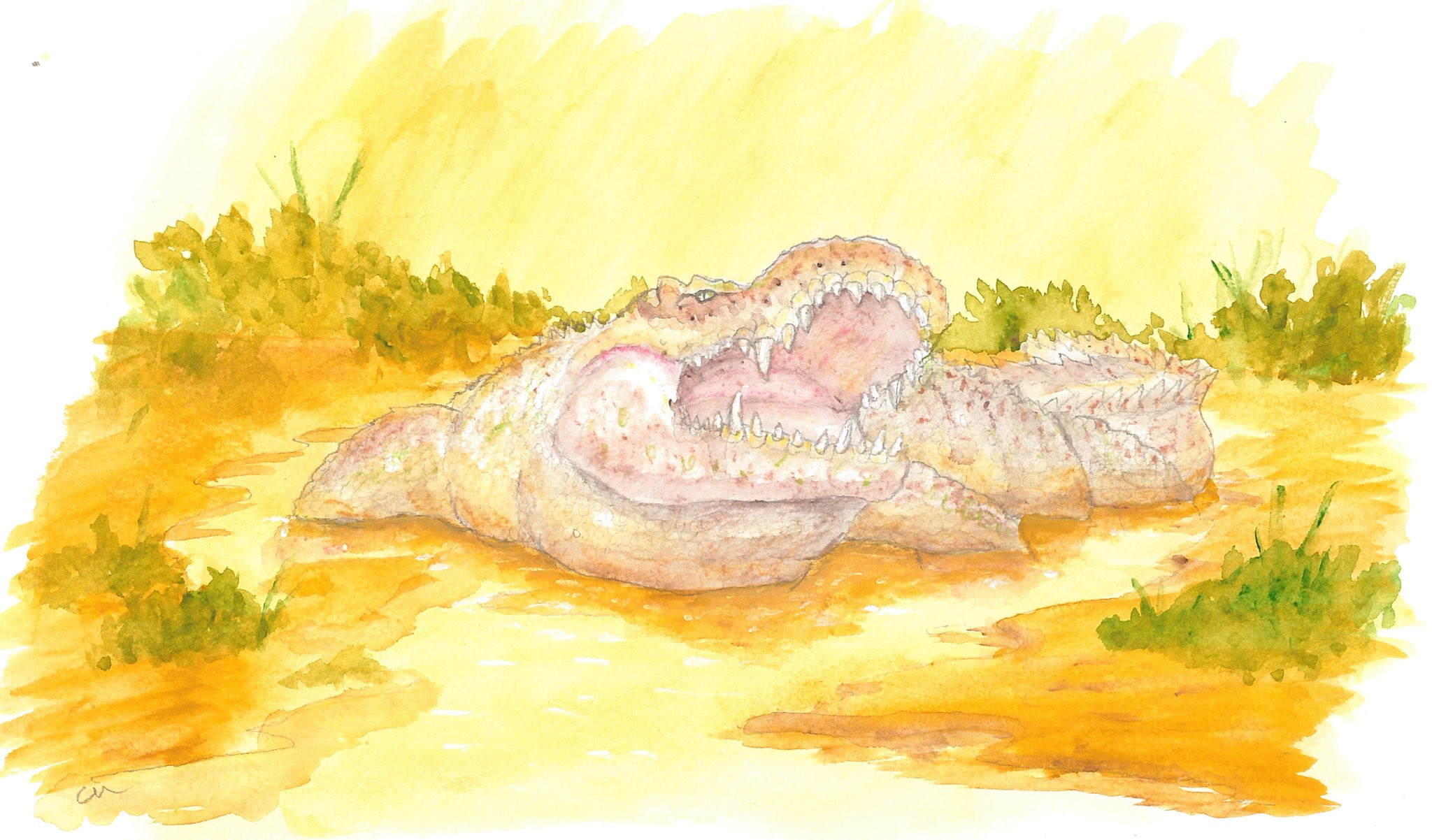|
Antaeusuchus
''Antaeusuchus taouzensis'' is a species of peirosaurid notosuchian from the Late Cretaceous Kem Kem Group of Morocco. It was described in 2021, and it is the only species in the genus ''Antaeusuchus''. It is the fourth notosuchian described from the region and the second Kem Kem peirosaurid after ''Hamadasuchus''. Discovery and naming ''Antaeusuchus'' is known from two specimens: the holotype NHMUK PV R36829, consisting of paired mandibles, and the paratype NHMUK PV R36874, a partial right mandible. Both specimens were commercially collected and recovered from unspecified beds of the Kem Kem Group near Jebel Beg'aa, Taouz township in the Errachidia Province of Morocco. Both fossils are preserved without distortion and in good condition, with damage mostly restricted to the teeth. The generic name derives from Antaeus, a giant from Greek and Berber mythology said to be buried in northern Morocco and the Ancient Greek σοῦχος, soukhos meaning crocodile. The species name refe ... [...More Info...] [...Related Items...] OR: [Wikipedia] [Google] [Baidu] |
Antaeusuchus And Hamadasuchus Comparison
''Antaeusuchus taouzensis'' is a species of peirosaurid notosuchian from the Late Cretaceous Kem Kem Group of Morocco. It was described in 2021, and it is the only species in the genus ''Antaeusuchus''. It is the fourth notosuchian described from the region and the second Kem Kem peirosaurid after '' Hamadasuchus''. Discovery and naming ''Antaeusuchus'' is known from two specimens: the holotype NHMUK PV R36829, consisting of paired mandibles, and the paratype NHMUK PV R36874, a partial right mandible. Both specimens were commercially collected and recovered from unspecified beds of the Kem Kem Group near Jebel Beg'aa, Taouz township in the Errachidia Province of Morocco. Both fossils are preserved without distortion and in good condition, with damage mostly restricted to the teeth. The generic name derives from Antaeus, a giant from Greek and Berber mythology said to be buried in northern Morocco and the Ancient Greek σοῦχος, soukhos meaning crocodile. The specie ... [...More Info...] [...Related Items...] OR: [Wikipedia] [Google] [Baidu] |
Kem Kem Group
The Kem Kem Group (commonly known as the Kem Kem beds) is a geological group in the Kem Kem region of eastern Morocco, whose strata date back to the Cenomanian stage of the Late Cretaceous. Its strata are subdivided into two geological formations, the lower Gara Sbaa Formation and the upper Douira Formation. It is exposed on an escarpment along the Algeria–Morocco border. The unit unconformably overlies Paleozoic marine units of Cambrian, Silurian and Devonian age, and is itself capped by limestone platform rock of Cenomanian-Turonian age. It primarily consists of deltaic deposits. The lower Gara Sbaa Formation primarily consists of fine and medium grained sandstone, while the Douira Formation consists of fining-upwards, coarse-to-fine grained sandstones intercalated with siltstones, variegated mudstones, and occasional thin gypsiferous evaporites. Dinosaur remains are among the fossils that have been recovered from the group.Weishampel, David B; ''et al.'' (2004). "Dinosau ... [...More Info...] [...Related Items...] OR: [Wikipedia] [Google] [Baidu] |
Notosuchian
Notosuchia is a suborder of primarily Gondwanan mesoeucrocodylian crocodylomorphs that lived during the Jurassic and Cretaceous. Some phylogenies recover Sebecosuchia as a clade within Notosuchia, others as a sister group (see below); if Sebecosuchia is included within Notosuchia its existence is pushed into the Middle Miocene, about 11 million years ago. Fossils have been found from South America, Africa, Asia, and Europe. Notosuchia was a clade of terrestrial crocodilians that evolved a range of feeding behaviours, including herbivory ('' Chimaerasuchus''), omnivory (''Simosuchus''), and terrestrial hypercarnivory (''Baurusuchus''). It included many members with highly derived traits unusual for crocodylomorphs, including mammal-like teeth, flexible bands of shield-like body armor similar to those of armadillos (''Armadillosuchus''), and possibly fleshy cheeks and pig-like snouts (''Notosuchus''). The suborder was first named in 1971 by Zulma Gasparini and has since undergone ... [...More Info...] [...Related Items...] OR: [Wikipedia] [Google] [Baidu] |
Peirosauridae
Peirosauridae is a Gondwanan family of mesoeucrocodylians that lived during the Cretaceous period. It was a clade of terrestrial crocodyliforms that evolved a rather dog-like form, and were terrestrial carnivores. It was phylogenetically defined in 2004 as the most recent common ancestor of ''Peirosaurus'' and Lomasuchinae and all of its descendants. Lomasuchinae is a subfamily of peirosaurids that includes the genus ''Lomasuchus''. Lomasuchinae was defined in the same 2004 study as the most recent common ancestor of ''Lomasuchus'' and Mahajangasuchini and all of its descendants. Mahajangasuchini, also constructed in the study, was defined as the most recent common ancestor of ''Mahajangasuchus'' and ''Uberabasuchus'' and all of its descendants. However, all more recent phylogenetic analyses placed ''Mahajangasuchus'' within its own family, Mahajangasuchidae, along with the newly named ''Kaprosuchus''. Genera The following list of genera follows Martinelli ''et al.'', 2012 unless ... [...More Info...] [...Related Items...] OR: [Wikipedia] [Google] [Baidu] |
Notosuchia
Notosuchia is a suborder of primarily Gondwanan mesoeucrocodylian crocodylomorphs that lived during the Jurassic and Cretaceous. Some phylogenies recover Sebecosuchia as a clade within Notosuchia, others as a sister group (see below); if Sebecosuchia is included within Notosuchia its existence is pushed into the Middle Miocene, about 11 million years ago. Fossils have been found from South America, Africa, Asia, and Europe. Notosuchia was a clade of terrestrial crocodilians that evolved a range of feeding behaviours, including herbivory ('' Chimaerasuchus''), omnivory (''Simosuchus''), and terrestrial hypercarnivory (''Baurusuchus''). It included many members with highly derived traits unusual for crocodylomorphs, including mammal-like teeth, flexible bands of shield-like body armor similar to those of armadillos (''Armadillosuchus''), and possibly fleshy cheeks and pig-like snouts (''Notosuchus''). The suborder was first named in 1971 by Zulma Gasparini and has since undergone ... [...More Info...] [...Related Items...] OR: [Wikipedia] [Google] [Baidu] |
Barrosasuchus
''Barrosasuchus'' is a genus of peirosaurid notosuchian from the Santonian of Argentina and part of the extensive peirosaurid record of Late Cretaceous Patagonia. It contains one species, ''Barrosasuchus neuquenianus''. ''B. neuquenianus'' is known from an almost complete skull and the majority of the articulated postcranial skeleton, making it the best preserved Patagonian peirosaurid. Discovery and naming In February of 2001 the Museo Carmen Funes conducted a joint expedition with the Royal Tyrell Museum at the Sierra Barrosa Locality, 30km north-east of Plaza Huincul, Neuquén province. There the team uncovered the bones of dinosaurs and mammals, bird footprints and notably a nearly complete peirosaurid fossil from the Bajo de la Carpa Formation. The holotype, MCF-PV 413, was found lying on its ventral side, the skull articulated with the remaining skeleton which consisted of both forelimbs, most of the vertebral column up to the sacrals, one hindlimb and semi-articulate oste ... [...More Info...] [...Related Items...] OR: [Wikipedia] [Google] [Baidu] |
Stolokrosuchus
''Stolokrosuchus'' is an extinct genus of neosuchian crocodylomorph that lived during the Early Cretaceous. Its fossils, including a skull with a long thin snout and bony knobs on the prefrontal, have been found in Niger. ''Stolokrosuchus'' was described in 2000 by Hans Larsson and Boubacar Gado. The type species is ''S. lapparenti''. They initially described it as related to Peirosauridae, if not a member of that family. One study has shown it to be related to ''Elosuchus''. However, more recent works usually find ''Stolokrosuchus'' to be one of the basalmost neosuchian, only distantly related to the elosuchid or pholidosaurid, ''Elosuchus ''Elosuchus'' is an extinct genus of neosuchian crocodyliform that lived during the Middle Cretaceous of what is now Africa (Niger, Morocco and Algeria). Description and taxonomy ''Elosuchus'' had an elongated snout like a gharial and was prob ...''. Phylogeny The cladogram following by Nicholl ''et al.'' 2021: References ... [...More Info...] [...Related Items...] OR: [Wikipedia] [Google] [Baidu] |
Mahajangasuchidae
Mahajangasuchidae is an extinct family of notosuchian crocodyliforms. It currently contains two genera, '' Mahajangasuchus'' and '' Kaprosuchus'', both of which lived during the Late Cretaceous in Gondwana. It is defined as the most inclusive clade containing ''Mahajangasuchus insignis'' but not ''Notosuchus terrestris'', '' Simosuchus clarki'', '' Araripesuchus gomesii'', ''Baurusuchus pachecoi'', '' Peirosaurus torminni'', '' Goniopholis crassidens'', '' Pholidosaurus schaumbergensis'', or ''Crocodylus niloticus''. Phylogenetically, Mahajangasuchidae is placed just outside pholidosaurids and more derived neosuchians. Defining characters of the family include fused nasals, a jaw articulation below the posterior maxillary tooth row, a deep mandibular symphysis that is oriented anterodorsally, and the formation of a hornlike posterodorsal process from the squamosal and parietal (which is much more pronounced in ''Kaprosuchus''). Phylogeny Cladogram showing the phylogenetic ... [...More Info...] [...Related Items...] OR: [Wikipedia] [Google] [Baidu] |
Gasparinisuchus
''Gasparinisuchus'' is an extinct genus of peirosaurid notosuchian known from the Late Cretaceous (Santonian to early Campanian stage) of Neuquén Province, Neuquén and Mendoza Provinces, western central Argentina. It contains a single species, ''Gasparinisuchus peirosauroides''. Discovery ''Gasparinisuchus'' is known only from two individuals. The holotype Museo Provincial de Ciencias Naturales, MOZ 1750 PV represented by partial skull and lower jaws with teeth and various associated postcranial skeleton including vertebrae and dermal plates which are currently missing. It was originally described by Gasparini (1982) and Gasparini ''et al.'' (1991) and referred to ''Peirosaurus torminni''. MOZ 1750 PV was found in the Loma de la Lata locality of the Neuquén Province, Patagonia. It was originally reported as collected from sediments of the Rio Colorado Subgroup, Neuquén Group. Later, Hugo and Leanza (2001) noted that this specimen was actually collected from ... [...More Info...] [...Related Items...] OR: [Wikipedia] [Google] [Baidu] |
Miadanasuchus
''Miadanasuchus'' is an extinct genus of peirosaurid which existed in the Maevarano Formation of Madagascar during the late Cretaceous period (Campanian The Campanian is the fifth of six ages of the Late Cretaceous Epoch on the geologic timescale of the International Commission on Stratigraphy (ICS). In chronostratigraphy, it is the fifth of six stages in the Upper Cretaceous Series. Campanian s ... age). It was first named by Erin L. Rasmusson Simons and Gregory A. Buckley in 2009 and the type species is ''Trematochampsa oblita''. Its teeth were irregularly spaced and variable in height. References Prehistoric pseudosuchian genera Late Cretaceous crocodylomorphs Maevarano fauna Crocodylomorphs of Madagascar Fossil taxa described in 2009 Maastrichtian life {{paleo-archosaur-stub ... [...More Info...] [...Related Items...] OR: [Wikipedia] [Google] [Baidu] |
Ontogenetic
Ontogeny (also ontogenesis) is the origination and development of an organism (both physical and psychological, e.g., moral development), usually from the time of fertilization of the egg to adult. The term can also be used to refer to the study of the entirety of an organism's lifespan. Ontogeny is the developmental history of an organism within its own lifetime, as distinct from phylogeny, which refers to the evolutionary history of a species. Another way to think of ontogeny is that it is the process of an organism going through all of the developmental stages over its lifetime. The developmental history includes all the developmental events that occur during the existence of an organism, beginning with the changes in the egg at the time of fertilization and events from the time of birth or hatching and afterward (i.e., growth, remolding of body shape, development of secondary sexual characteristics, etc.). While developmental (i.e., ontogenetic) processes can influence su ... [...More Info...] [...Related Items...] OR: [Wikipedia] [Google] [Baidu] |
Mahajangasuchus
''Mahajangasuchus'' is an extinct genus of crocodyliform which had blunt, conical teeth. The type species, ''M. insignis'', lived during the Late Cretaceous; its fossils have been found in the Maevarano Formation in northern Madagascar. It was a fairly large predator, measuring up to long. Discovery and naming With the inception of the Mahajanga Basin Project (MBP) in 1993, led by Dr. David Krause, came a significant increase of discoveries and research into the fauna of the Maastrichtian Maevarano Formation in northern Madagascar. This included a variety of crocodylomorphs with the largest specimen being a well preserved disarticulated skeleton discovered in 1995 roughly 1 km south-east of the village of Berivotra. This skeleton, specimen ''UA 8654'', consisted of a complete left and partial right mandible, vertebrae of the cervical, dorsal, saccral and caudal regions, several ribs as well as material of the pectoral, pelvic girdle and limb bones. Osteoderms and isolated t ... [...More Info...] [...Related Items...] OR: [Wikipedia] [Google] [Baidu] |




